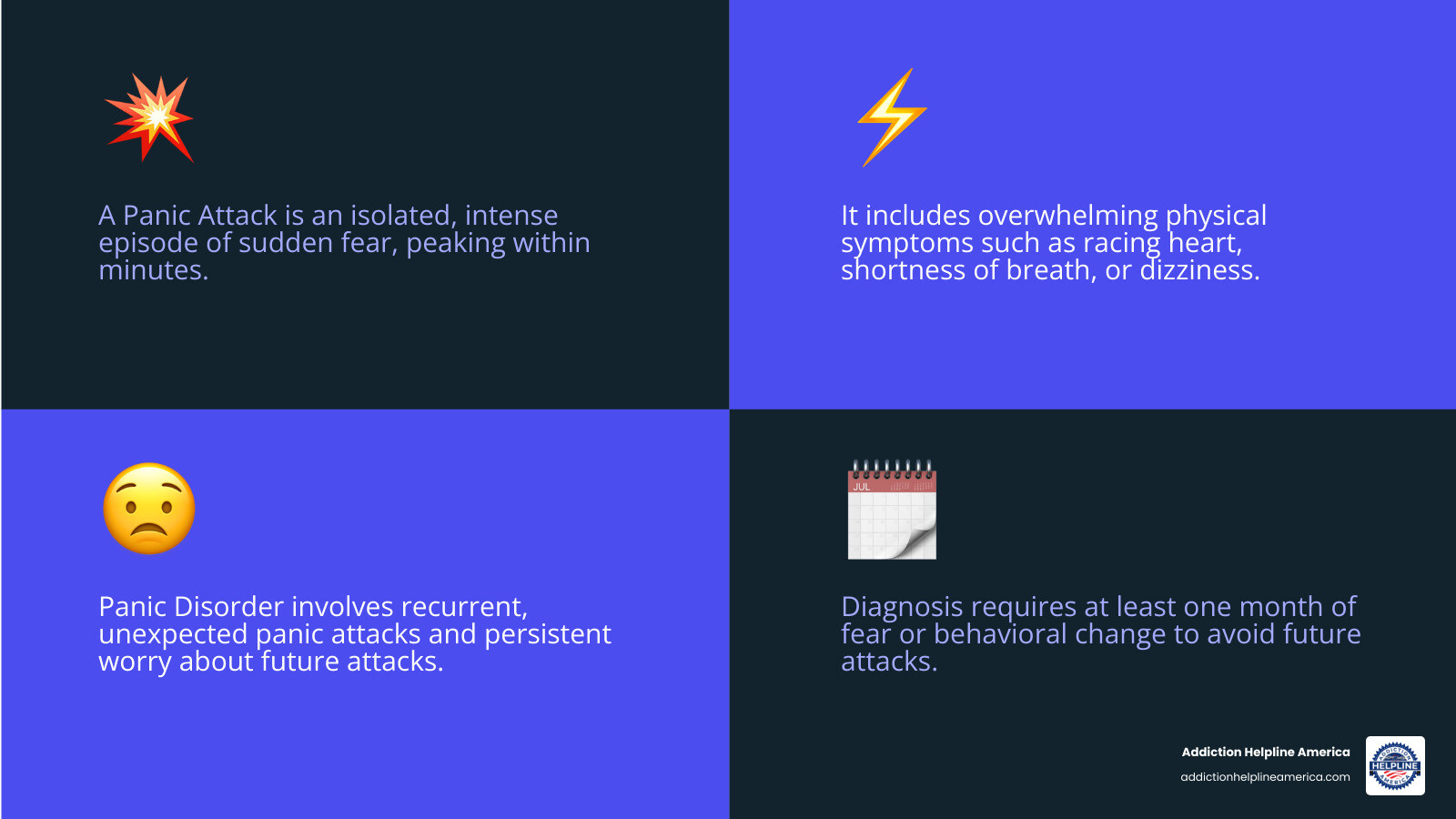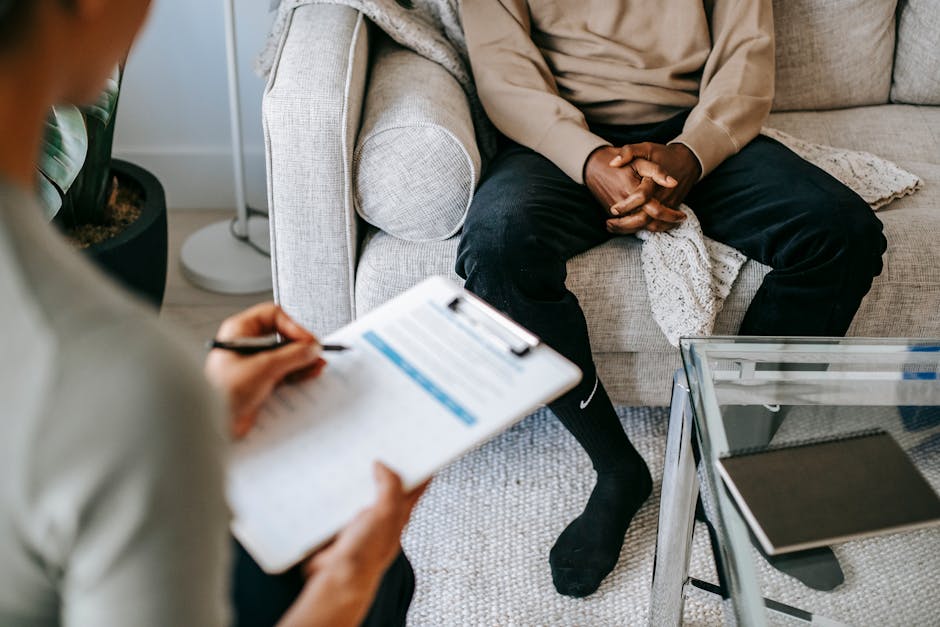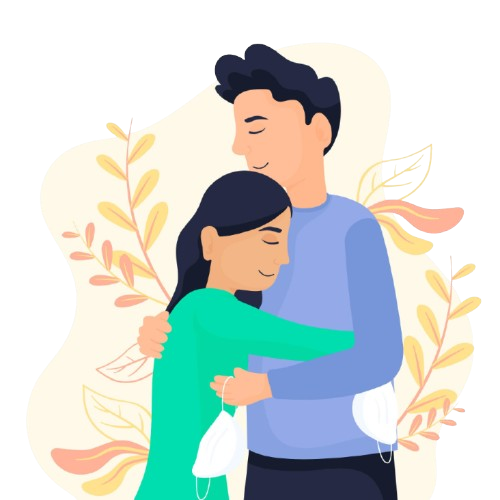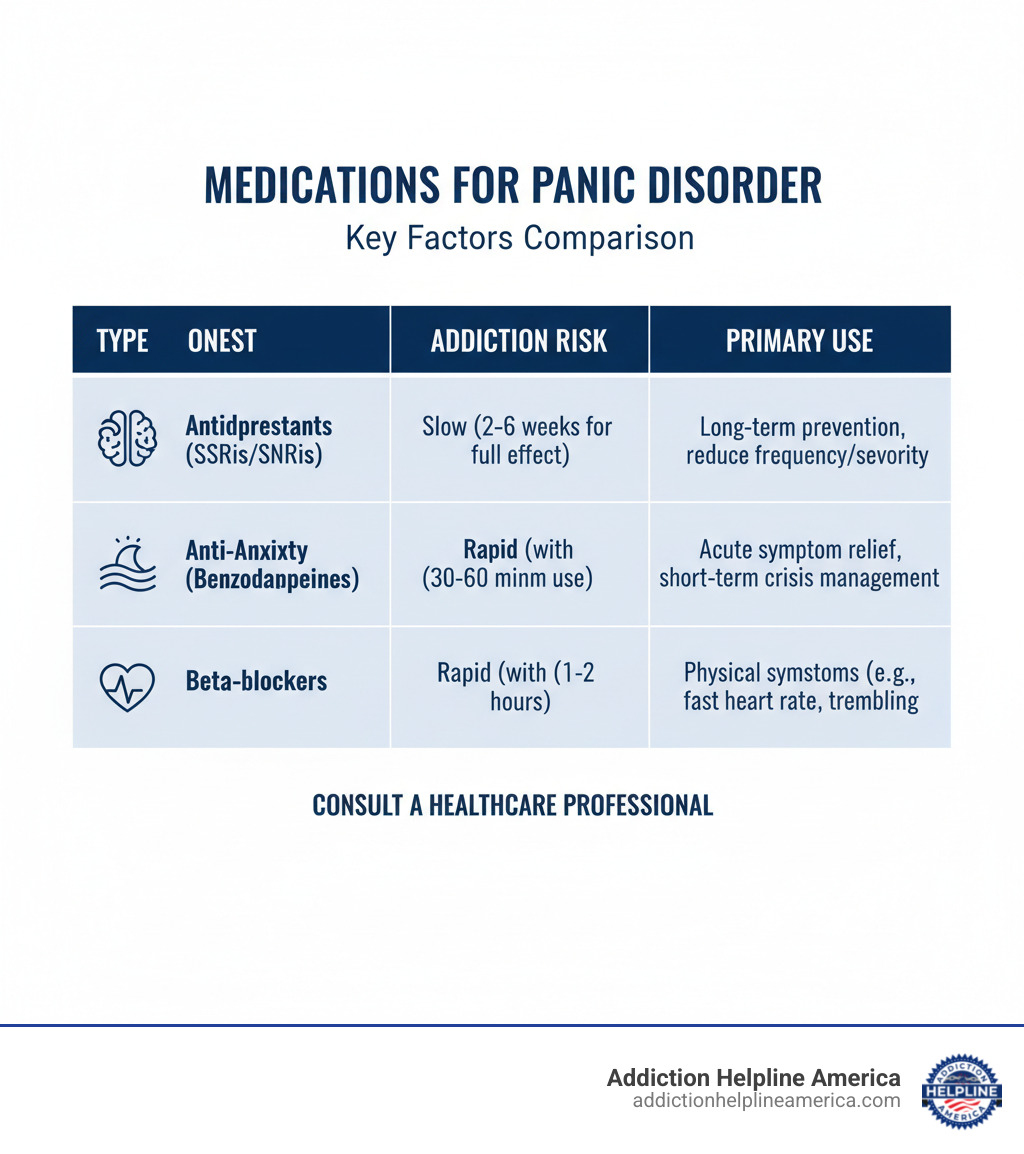Your Journey to a Healthier Life Starts Here
Free Insurance Verification
Verify Your Treatment Coverage
Verify Your Treatment Coverage
Panic Disorder Treatment typically involves psychotherapy, medication, and lifestyle changes. Most people see significant improvement within weeks to months, with 70-90% of those in evidence-based treatment becoming panic-free or experiencing major symptom reduction.
Quick Overview:
A panic attack feels like an invisible surge of terror that convinces you something terrible is happening. Panic attacks are not dangerous, but when they happen repeatedly and you live in fear of the next one, you may have panic disorder. This condition affects 2-3% of Americans each year, but it is one of the most treatable anxiety conditions.
The difference is crucial: a panic attack is a single episode of intense fear. Panic disorder involves recurrent, unexpected attacks and at least a month of worrying about having more or changing your behavior to avoid them. Many people with panic disorder also develop agoraphobia—fear of situations where escape might be difficult during an attack, which can severely limit their life.
At Addiction Helpline America, we understand that seeking help takes courage. This guide covers how panic disorder is diagnosed, what causes it, which treatments work, and what to expect on your recovery journey.

Panic disorder is an anxiety disorder defined by recurrent, unexpected panic attacks and persistent worry about future attacks. The attacks are intense episodes of fear that peak within minutes and involve frightening physical and mental symptoms, such as a racing heart, shortness of breath, dizziness, and a feeling of dread or fear of dying. While terrifying, panic attacks are not physically dangerous.
For a diagnosis of panic disorder, a healthcare provider will use criteria from the Diagnostic and Statistical Manual of Mental Disorders (DSM-5). This requires:
Ruling out medical conditions like thyroid or heart issues is a crucial first step. Panic disorder also frequently co-occurs with other conditions, which can complicate Panic Disorder Treatment:
The exact cause is a complex mix of factors:
If you’re experiencing panic-like symptoms, see a healthcare provider. Your primary care provider (PCP) can perform an initial evaluation, including a physical exam and blood tests, to rule out other medical causes. They may then refer you to a mental health specialist, like a psychiatrist or therapist, for specialized care.
To prepare for your appointment, list your symptoms, any major life stressors, your medical history, and all medications or substances you use. Seeking professional help is a sign of strength and the first step toward regaining control.
Effective Panic Disorder Treatment is available and works remarkably well. Research shows that 70-90% of people who receive Cognitive Behavioral Therapy see significant improvement, and many become panic-free within months. Combining therapy with medication can be even more effective.


Take the first step towards a healthier life! Call now to connect with our compassionate team and start your recovery journey today. Your path to healing awaits!
Our recovery specialists are available 24/7 to provide support, and all calls are confidential and free. Reach out anytime – we’re here to help!
Recovery takes time. You may notice improvements within several weeks, with more dramatic results appearing over several months. At Addiction Helpline America, we specialize in connecting you with treatment that addresses both panic disorder and any co-occurring substance use challenges.
Psychotherapy teaches you lifelong skills to manage your mind and is considered the most effective first-line treatment for panic disorder.
Cognitive Behavioral Therapy (CBT) is the gold standard. It changes how you respond to panic by teaching you that the physical sensations you fear are not dangerous. CBT targets distorted thoughts (e.g., “My heart is racing, I’m having a heart attack!”) and helps you replace them with realistic ones (e.g., “My heart is racing because I’m anxious, and anxiety isn’t dangerous”). This is called cognitive restructuring.
Key components of CBT include:
Acceptance and Commitment Therapy (ACT) is another approach that teaches you to accept anxious thoughts and feelings without fighting them, allowing you to focus on living a life aligned with your values.
When symptoms are severe, medication can be a crucial part of recovery. It can provide the stability needed to engage fully in therapy.

Finding the right medication and dosage can take time and requires close collaboration with your doctor.
SSRIs (Selective Serotonin Reuptake Inhibitors) and SNRIs (Serotonin and Norepinephrine Reuptake Inhibitors) are the most commonly prescribed medications for panic disorder. They work by balancing brain chemicals like serotonin to reduce the frequency and severity of panic attacks. Common examples include fluoxetine (Prozac), sertraline (Zoloft), and venlafaxine (Effexor XR).
These medications take 2 to 8 weeks to reach full effect, so patience is key. They are not addictive, but you should not stop taking them abruptly. Treatment typically continues for at least six months to prevent relapse.
Benzodiazepines, like alprazolam (Xanax), work quickly by calming the nervous system. They are useful for acute panic attacks or as a short-term bridge while waiting for an SSRI to work. However, they are habit-forming, and tolerance can develop quickly. Abruptly stopping them can be dangerous, and they can interfere with the learning process in CBT. Due to the high risk of misuse and addiction, they are generally not a long-term solution, especially for those with a history of substance use.
While professional Panic Disorder Treatment is essential, your daily choices can significantly support your recovery. These self-help strategies are practical tools to help you regain control.
When a panic attack occurs, try to stay where you are (if safe) and use grounding techniques. Focus on your breathing and remind yourself that the attack is temporary and not harmful. The FAQ section of this guide provides more detailed steps for managing an attack.

Your physical health directly impacts your mental well-being. Making positive changes in these areas can lower your body’s panic threshold.
Isolation strengthens anxiety, so connection is a vital part of recovery.
Patience is key for everyone involved, as recovery is not always a straight line. A strong support system can carry you through the most challenging moments.
Think of your Panic Disorder Treatment as a journey where you are the driver and your healthcare team is your guide. Getting the most from your appointments starts with preparation. Bring a list of your symptoms, questions, and current medications to ensure you cover everything.
Sticking with your treatment plan is often the hardest part. Consistency with therapy, medication, and lifestyle changes is what turns short-term improvement into lasting recovery. If you feel something isn’t working, talk to your provider about adjusting the plan rather than abandoning it.
The long-term outlook for those who commit to treatment is very encouraging. Most people see significant improvement, and many become completely panic-free. Treatment teaches you lifelong skills to manage anxiety, so even if you experience a setback during a stressful time, you have the tools to get back on track. A few booster therapy sessions can often help.
What happens if panic disorder goes untreated? The consequences can be severe. Many people develop agoraphobia, becoming so fearful of having an attack in public that they can’t leave home. This can lead to job loss and social isolation.
Untreated panic disorder is also strongly linked to substance use. People may turn to alcohol or drugs for temporary relief, which can spiral into a co-occurring substance use disorder. This creates a vicious cycle where substances worsen anxiety, leading to more use. Chronic panic disorder also frequently leads to depression and, in some cases, suicidal thoughts. If you are having thoughts of self-harm, please seek help immediately. Addiction Helpline America can connect you with crisis resources and treatment.
Regarding practical considerations like driving, if panic attacks affect your ability to operate a vehicle safely, it’s important to speak with your doctor. Once treatment is effective, most people can resume all normal activities without restriction.
Taking the first step toward treatment takes courage, but every step after is an investment in reclaiming your life from panic.

Take the first step towards a healthier life! Call now to connect with our compassionate team and start your recovery journey today. Your path to healing awaits!
Our recovery specialists are available 24/7 to provide support, and all calls are confidential and free. Reach out anytime – we’re here to help!
Here are clear, honest answers to common questions about Panic Disorder Treatment.
While you want immediate relief, treatment takes time. However, improvements often come sooner than you think. With psychotherapy like CBT, many people notice a reduction in symptoms within several weeks, with significant improvement over several months (a typical course is 12-16 weeks).
Medications work on a different timeline. SSRIs and SNRIs typically take 2 to 8 weeks to reach their full effect. It’s vital to continue taking them as prescribed during this period. Benzodiazepines offer rapid relief but are generally used only for short-term management due to risks of dependence.
The bottom line is that patience and consistency are crucial. Most people who stick with their treatment plan see significant improvement within a few months.
While mental health professionals often focus on “management” rather than “cure,” many people achieve complete freedom from panic attacks. With effective Panic Disorder Treatment, a large number of individuals become panic-free or reduce their symptoms so dramatically that panic no longer controls their lives. Studies show high success rates for treatments like CBT.
The goal is to learn long-term coping skills that prevent relapse and allow you to live without the constant fear of another attack. You can reach a point where panic no longer dictates your life choices.
When panic strikes, having a plan can make all the difference. Here are the key steps:
Panic attacks are not life-threatening. Each time you use these tools to get through an attack, you build confidence and reduce the power panic has over you.
If you’re struggling, we’re here to help you find the right treatment. At Addiction Helpline America, we connect people with compassionate, evidence-based care. Find personalized mental health and addiction treatment options today.
We hope this guide has given you not just information, but hope. Here’s what we want you to remember: Panic disorder is highly treatable. This is an evidence-backed fact. The overwhelming majority of people who seek proper treatment—combining psychotherapy like CBT, appropriate medication, and lifestyle changes—get better.
We understand that taking the first step is daunting. The anxiety you’re trying to address can make it feel impossible to reach out. That’s why we exist.
At Addiction Helpline America, we’ve helped thousands of people steer panic disorder, often alongside co-occurring substance use issues. Our mission is simple: we provide free, confidential guidance to connect you with the right recovery program from our trusted network of treatment centers.
Recovery is not just possible—it’s probable with the right support. A life free from the constant fear of panic is waiting for you. You just need to take one courageous step toward it.
Find personalized mental health and addiction treatment options today
You don’t have to do this alone. We’re here to help you find your path to recovery.
Are you or a loved one struggling with addiction? Call today to speak to a treatment expert.
Calls to any general helpline will be answered or returned by one of the treatment providers listed, each of which is a paid advertiser:
Our helpline is available 24 hours a day, 7 days a week at no cost to you and with no obligation for you to enter into treatment. We are committed to providing support and guidance whenever you need it.
In some cases, Addiction Helpline America charges our verified partner a modest cost per call. This fee helps us cover the costs of building and maintaining our website, ensuring that we can continue to offer this valuable service to those in need.
Calls to the general helpline will be answered or returned by one of the listed treatment providers, all of whom are paid advertisers.
By using the helpline, you agree to the terms of use. We do not earn any commission or fee based on the treatment provider selected by the caller, and there is no obligation to pursue treatment.
This service is not affiliated with Alcoholics Anonymous World Services, Inc.